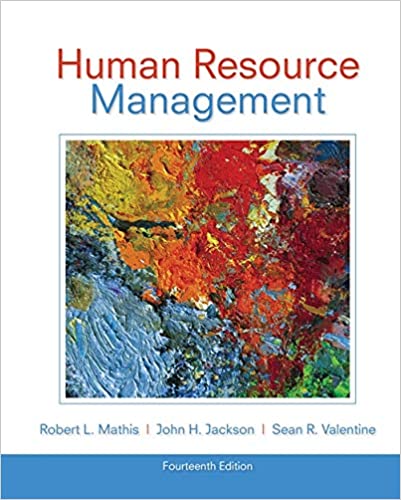
Human Resource Management 14th Edition by Robert Mathis,Sean Valentine,John Jackson
Edition 14ISBN: 978-1133953104
Human Resource Management 14th Edition by Robert Mathis,Sean Valentine,John Jackson
Edition 14ISBN: 978-1133953104 Exercise 1
"Evaluate" before "Terminate"
The move to terminate potentially violent or dangerous employees can be a difficult one. If the decision is made haphazardly or hastily, firing problem employees can open up an organization to claims of wrongful termination or even illegal discrimination. If individuals are retained, a company can be found negligent, ultimately being held responsible for any wrongdoing and harm that occurs as a result of keeping them around. Consequently, companies must try to strike a reasonable balance between being too proactive, and not being judicious enough.
Such decision-making difficulties and dilemmas are illustrated in the recent court case Mary Wolski v. City of Erie. The City of Erie had fired Ms. Wolski, a fire truck driver who had been employed in the fire fighting group for many years, because the organization believed that she was a safety problem in the workplace. Years previously, her mother had passed away, causing Ms. Wolski to become very depressed. As a result, she took extensive leave from work to seek treatment and recover from her psychological troubles. While on leave, she attempted to poison herself with carbon monoxide by starting a fire at her father's house and consuming an overdose of medication.
Such conduct was considered highly dangerous by her employer, and an investigation was initiated by the City of Erie. The findings of the inquiry resulted in her termination, so Ms. Wolski subsequently filed a lawsuit claiming that the organization's decision to terminate her violated requirements of the ADA. The court ruled in her favor because the organization did not conduct an "individualized assessment" of Ms. Wolski before the termination decision. The move to fire her appeared to be based largely on an evaluation of her conduct, which was likely caused by her documented depression.
This case presents many important implications for HR professionals. For instance, employers should get the proper input from medical professionals who understand the mental and physical challenges that impair employees' ability to perform their work. HR also needs to talk with employees to determine whether individual impairments negatively impact their performance of essential job activities. In addition, reasonable accommodations should be identified, and employee requests for assistance should be secured in writing. Finally, retention and termination decisions should be business-related and objective in nature. 64
QUESTIONS
1. Based on your work experiences, identify examples of behaviors that might be considered dangerous by managers, supervisors, and/or coworkers. How did your employers respond, and was anyone terminated?
2. If you were an HR professional, how would you handle the termination of a potentially dangerous employee? What policies might you create to make your organization less susceptible to wrongful termination or discrimination lawsuits?
The move to terminate potentially violent or dangerous employees can be a difficult one. If the decision is made haphazardly or hastily, firing problem employees can open up an organization to claims of wrongful termination or even illegal discrimination. If individuals are retained, a company can be found negligent, ultimately being held responsible for any wrongdoing and harm that occurs as a result of keeping them around. Consequently, companies must try to strike a reasonable balance between being too proactive, and not being judicious enough.
Such decision-making difficulties and dilemmas are illustrated in the recent court case Mary Wolski v. City of Erie. The City of Erie had fired Ms. Wolski, a fire truck driver who had been employed in the fire fighting group for many years, because the organization believed that she was a safety problem in the workplace. Years previously, her mother had passed away, causing Ms. Wolski to become very depressed. As a result, she took extensive leave from work to seek treatment and recover from her psychological troubles. While on leave, she attempted to poison herself with carbon monoxide by starting a fire at her father's house and consuming an overdose of medication.
Such conduct was considered highly dangerous by her employer, and an investigation was initiated by the City of Erie. The findings of the inquiry resulted in her termination, so Ms. Wolski subsequently filed a lawsuit claiming that the organization's decision to terminate her violated requirements of the ADA. The court ruled in her favor because the organization did not conduct an "individualized assessment" of Ms. Wolski before the termination decision. The move to fire her appeared to be based largely on an evaluation of her conduct, which was likely caused by her documented depression.
This case presents many important implications for HR professionals. For instance, employers should get the proper input from medical professionals who understand the mental and physical challenges that impair employees' ability to perform their work. HR also needs to talk with employees to determine whether individual impairments negatively impact their performance of essential job activities. In addition, reasonable accommodations should be identified, and employee requests for assistance should be secured in writing. Finally, retention and termination decisions should be business-related and objective in nature. 64
QUESTIONS
1. Based on your work experiences, identify examples of behaviors that might be considered dangerous by managers, supervisors, and/or coworkers. How did your employers respond, and was anyone terminated?
2. If you were an HR professional, how would you handle the termination of a potentially dangerous employee? What policies might you create to make your organization less susceptible to wrongful termination or discrimination lawsuits?
Explanation
Termination refers to stage in employee ...
Human Resource Management 14th Edition by Robert Mathis,Sean Valentine,John Jackson
Why don’t you like this exercise?
Other Minimum 8 character and maximum 255 character
Character 255


